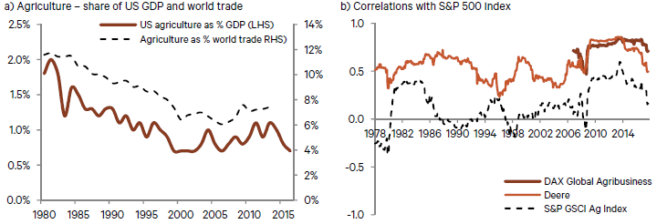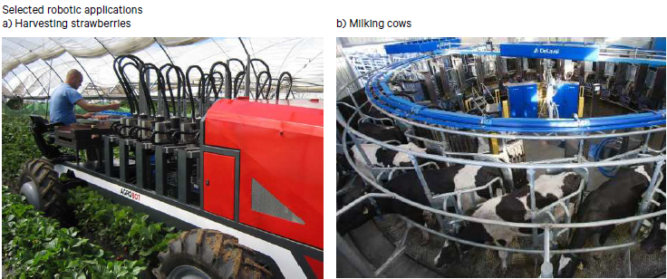Whenever we go shopping at the nearest supermarket, early in the morning or late in the evening, we have a wide range of products to choose from. Fresh meat, fish, vegetables, and fruits, as well as plenty of other goods – all that we require is on the shelves, and we don’t even think about how it all got there, how many people worked to provide us with the possibility to do our usual task – go shopping. In the 21st century, we are pampered. Pampered with a choice we have. Lots of efforts are made to give all of us the opportunity to cook a good dinner for our families. One agriculture professor from the Iowa State University said: “Agronomy and crop production aren’t rocket science – it is way more complicated”. In the era when Elon Mask is launching his rockets, technologies on Earth also don’t stay still and such seemingly outdated industries as agriculture are gaining a new momentum with the implementation and development of the latest technologies. It is the total disruption of an old profession that put the whole agriculture industry on the new level, offering attractive long-term results. Agricultural technology (Agtech) is on the very beginning of its development but already has high chances to become a large, growing market with excellent investment perspectives. So, 21st century is the heyday of Agtech – the new chapter in the whole agriculture industry with new winners and losers, benefits and challenges. What does it promise us and how are farmers re-inventing their game? What perspectives does it have?
Agtech. What Is It, Why Now, and Who Is At the Helm?
There are always more questions than answers. Starting from the very beginning and defining Agtech as a concept, we should mention that Agtech means different things for different people. Some of them even question whether “Agtech” is a distinct concept, given that agriculture’s embrace of technology has been a permanent feature, dating back thousands of years. But is it the same technology as were thousand years ago? Very unlikely. Large and steadily growing modern Agtech market consists of seven themes that offer a combined market of $192bn in the nearest future:
- Biotech;
- Biologicals;
- Precision ag;
- Robotics;
- Vertical farming;
- Aquaculture;
- Supply chain.
All these themes create together the “Agtech” concept and are aimed to change the existing agriculture industry. Agtech markets offer 5{3fbfd6f1e6b19884051837dbbbebf333964dd5fac151615ffbd47b80e5ecc87a} CAGR on average, but if a consumer, regulatory, and technical hurdles are overcome, some of the markets could rise to five times larger.
Why is the adoption of agricultural technology happening now? To date, technologies are facing the problem of pressure on immigration. The collision of tech and politics acted as a trigger and gave a push to Agtech development. It is now serving as a key to solving many pressures on global demand and supply of the food. Two main events that can be called the primary drivers of the Agtech growth are:
- The ubiquity of financially available and at the same time powerful computer/mobile devices and communications;
- Political influences on immigration.
At the same time, two large markets are increasing, and we expect the results of this growth in this year:
- Robotics. In the nearest future we expect the launch of the first commercial robot tractors in India and Japan;
- Gene-editing . US regulations that will give a green light for the new forms of gene engineering are expected in this year.
Among other factors influencing the Agtech demand is the supply of food, and influences on global demand. Rapid urbanization, severe environmental constraints together with growing pesticide resistance and threats to food security, falling growth in crop yields, and poor farm economics have resulted into one powerful mechanism driving the Agtech development and demand. Some of these factors are not new, but their coincidence has triggered the next Agtech cycle that gives a new life to an old profession.
Together with growth and development, investment is also accelerating as well as it has happened with the related digital healthcare sector. Venture capital investments in the Agtech industry have tripled since 2013, and the numbers keep growing.
The Road to Success. Challenges and Risks for Agtech Growth.
The Agtech markets are increasing, and this is a proven fact. The question is when will be the first results of this growth as several challenges and risks have to be overcome. Among the most critical barriers on the Agtech road to success are regulatory, consumer, and technical hurdles facing biotech, precision ag, and robotics. When these barriers are destroyed, the Agtech markets will have all chances to increase up to five times. Among other challenges and risks that Agtech companies are facing there are:
- “Farming isn’t rocket science – it is a more complicated way.” In this industry, operating conditions may vary not only between, but also within fields, causing additional challenges for communications, robotics, and precision ag. Among such hurdles may be buildings, foliage, mud, and varying plant/weed growth.
- All farmers are different, but they have one thing in common – they all are businessmen. They don’t want to be lectured and are not ready to change their usual way of life. Volatile and depressed farm incomes are the dominant drivers of adoption in the long-term but create challenges that can’t be neglected in the short-term.
- Gathering data is only half the battle. The challenge is converting this data into information, and after – into the knowledge. In addition to this, data privacy and ownership concerns also need to be addressed.
Even if taking into account all the challenges and risks for Agtech, this industry offers attractive investment opportunities. As well as with all disruptive technologies, with Agtech coming all players of this enormous game will be divided into the winners and losers. Who will skim off the top and who will have to change the industry to keep the business afloat? Agtech appearance will be positive for farmers (field, indoor or aquaculture) and the OEMs, but disruptive for companies supplying pesticides/fertilizer inputs as well as for grain processors/traders. Among all the Agtech segments, aquaculture is the most attractive one, as technological change has already happened in this sector and has healthy growth dynamics.
Now it’s time to size the market and scale all the opportunities. Evaluating altogether, we identify markets worth $192bn growing at a 5{3fbfd6f1e6b19884051837dbbbebf333964dd5fac151615ffbd47b80e5ecc87a} CAGR over the next five years. Excluding aquaculture and the supply chain, thus focusing on technologies directly affecting agriculture, the markets are worth $82bn, and we expect them to grow at 8{3fbfd6f1e6b19884051837dbbbebf333964dd5fac151615ffbd47b80e5ecc87a} pa out to 2021.
Aliens in Agriculture. Key Agtech Technologies Entering the Game.
Among all technologies in the agricultural sector, six ones are offering significant potential. Let’s consider each of these seven “aliens” of agriculture separately and evaluate the investment opportunities.
- Biotech. It is the most exciting and promising technology among all others. Biotech offers high potential to increase crop yields, but with a much smaller environmental impact. Within the “biotech” concept there are a lot of definitions – selective breeding, interspecies crosses, genetic engineering, mutagenesis (mutational breeding), transgenesis (genetic modification), RNA interference, gene editing (CRISPR/TALEN), and genomic selection. The main focus nowadays is on the plant/animal breeding and animal health, which represent $65bn market opportunity growing at 5{3fbfd6f1e6b19884051837dbbbebf333964dd5fac151615ffbd47b80e5ecc87a} CAGR.
- Biologicals. According to the BioAg Alliance, the “biologicals” definition is the naturally occurring solutions, such as microbial, beneficial insects, plant extracts, and other organic material allowing farmers to improve crop health and productivity. Biologicals can complement or entirely replace traditional fertilizers and chemicals and help lower the environmental impact of agriculture. This technology represents a $5bn market growing at a 9{3fbfd6f1e6b19884051837dbbbebf333964dd5fac151615ffbd47b80e5ecc87a} CAGR.
- Precision agriculture. Data is the new oil. Precision ag or digital farming comprises data gathering, data analysis, and command and control technologies. Precision ag is the most promising of the many “ag” technologies with the high potential for true productivity and efficiency. The “precision ag” term comprises many related concepts, including digital farming, decision ag, smart farming, and the connected farm. It means an interconnected ecosystem of sensors that gather data, computers that turn data into actionable information, and communication systems that inform both decision makers (farmers and their advisers) and machines themselves.
- Robotics. It is the game-changing technology in agriculture. Many challenges are on the way to robotics adoption, but once they are overcome, robots will transform the whole economics of farming, cutting costs and making it a much more capital-intensive business. In essence, robots are being developed to take over any agricultural task that is currently done by humans. The first machines are already in or close to production. Japan is racing to launch first-generation driverless tractors by 2018 while Spain’s Agrobot already sells a robotic strawberry picker. But the timing of matching or exceeding human performance remains uncertain.
- Vertical farming. With its origins in greenhouse systems, LED, IoT, and big data, technologies are combined within an entirely controlled environment to eliminate all of the fads that traditional agriculture faces operating in an outdoors environment. Vertical farming makes use of several technologies. It gives several variations for its developments: it may take place in a warehouse or container box; it may be stacked trays or vertical growing systems, and it may or may not be fully automated. However, there are general features such as optimized with data science light, water, and nutrients for each plant and the use of hydroponics rather than soil that allows crops to be grown, stacked one above the other.
- Aquaculture. This technology represents the most promising investment opportunity of the 21st century. The demand for fish is expected to grow over the next ten years, benefiting from constraints on the production of land-based animal proteins as well as a trend towards healthier eating. Thus, the growth in aquaculture is expected to reach +34{3fbfd6f1e6b19884051837dbbbebf333964dd5fac151615ffbd47b80e5ecc87a} over this period. Fish farming involves raising fish from juveniles in a contained environment (at sea or on land) until they reach harvest weight. Most fish need feeding during this process and – in more sophisticated, land-based closed containment facilities – the water is treated (oxygen levels are managed and waste materials removed) and its temperature is controlled. The global market for farmed fish (aquaculture) accounts for 45{3fbfd6f1e6b19884051837dbbbebf333964dd5fac151615ffbd47b80e5ecc87a} of total fish supply by weight. By value, the output of the aquaculture industry amounted to USD160bn globally in 2015 and is expected to grow by 39{3fbfd6f1e6b19884051837dbbbebf333964dd5fac151615ffbd47b80e5ecc87a} through to 2025.
Conclusions and Highlights
Let’s sum up all the reviewed above and finally find out what is happening today with the agricultural industry and what will be expected from this industry in the nearest future.
- Low-cost computer processing power, cheap sensors, the ubiquity of smart, mobile devices, and dramatic improvements in the speed and cost of broadband have all combined to allow the digitization of agriculture;
- Big data together with artificial intelligence (AI) and machine learning have served as the main triggers for the agricultural revolution;
- Developments in biotechnology (gene editing) allowed to make the next step change in agricultural productivity;
- Main Agtech technologies offer a combined market of $192bn in the nearest future;
- Among the most critical barriers on the Agtech adoption are regulatory, consumer, and technical hurdles facing biotech, precision ag, and robotics.
Severe challenges and barriers are on the Agtech way, but the expected results of these technologies implementation are too attractive to back down. An old profession has got a new life, and today, the new technologies are going to change the whole agricultural industry drastically, providing us with best results we have ever got.








Recent Comments